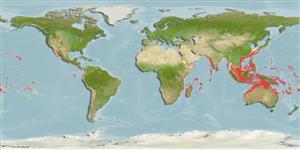Common names from other countries
>
Acanthuriformes (Surgeonfishes) >
Acanthuridae (Surgeonfishes, tangs, unicornfishes) > Acanthurinae
Etymology: Acanthurus: Greek, akantha = thorn + Greek, oura = tail (Ref. 45335); xanthopterus: Name from Greek 'xanthos' for yellow and 'ptero' for fin; referring to the yellow color of the outer part of the pectoral fin (Ref. 37792).
More on author: Valenciennes.
Environment: milieu / climate zone / depth range / distribution range
Ecologia
marinhas associadas(os) a recifes; intervalo de profundidade 1 - 100 m (Ref. 9267), usually 5 - 90 m (Ref. 27115). Tropical; 24°C - 28°C (Ref. 27115); 35°N - 35°S, 23°E - 77°W
Indo-Pacific: coast of East Africa to the Hawaiian Islands and French Polynesia, north to southern Japan, south to the Great Barrier Reef and New Caledonia. Eastern Pacific: lower Gulf of California and Clipperton Island to Panama and the Galapagos Islands.
Tamanho / Peso / Idade
Maturity: Lm ? range ? - ? cm
Max length : 70.0 cm TL macho/indeterminado; (Ref. 4795); common length : 50.0 cm TL macho/indeterminado; (Ref. 30573); idade máx. registrada: 29 anos (Ref. 127555)
Espinhos dorsais (total) : 8 - 9; Raios dorsais (total) : 25 - 27; Espinhos anais: 3; Raios anais : 23 - 25. Body purplish gray when alive; grayish brown when preserved; a region of dull yellow in front of eye, a lesser extension posterior to lower part of eye; outer 1/3 of pectoral fin yellow, extreme distal part hyaline; dorsal and anal fins yellowish grey basally, dull yellow distally; caudal fin base whitish; caudal fin purplish. Anterior gill rakers 16-24, posterior 17-22. Caudal spine small.
Live in various reef habitats, sand slopes and lagoons (Ref. 48637). Juveniles inhabit shallow, protected, turbid inshore waters while adults prefer deeper areas of protected bays and lagoons. Also in outer reef areas (Ref. 1602). Benthopelagic (Ref. 58302). Schooling species, feed on diatoms, detritus film of sand, filamentous algae, hydroids, and pieces of fish (Ref. 1602, 48637). Probably the only surgeonfish that readily takes bait (Ref. 12484).
Ciclo de vida ou comportamento de acasalamento
Maturities | Reprodução | Spawnings | Egg(s) | Fecundities | Larvas
Randall, J.E., 1956. A revision of the surgeonfish genus Acanthurus. Pac. Sci. 10(2):159-235. (Ref. 1920)
Status na Lista Vermelha da UICN (Ref. 130435)
CITES (Ref. 128078)
Not Evaluated
Uso pelos humanos
Pescarias: pouco comercial; Aquário: Espécies comerciais
Ferramentas
Relatórios especiais
Baixar XML
Fontes da internet
Estimates based on models
Preferred temperature (Ref.
115969): 23.3 - 29, mean 27.7 (based on 2980 cells).
Índice de diversidade filogenética (Ref.
82804): PD
50 = 0.5000 [Uniqueness, from 0.5 = low to 2.0 = high].
Bayesian length-weight: a=0.01413 (0.00613 - 0.03255), b=3.00 (2.79 - 3.21), in cm Total Length, based on LWR estimates for this (Sub)family-body shape (Ref.
93245).
Nível Trófico (Ref.
69278): 2.9 ±0.23 se; based on food items.
Resiliência (Ref.
120179): Baixo, tempo mínimo de duplicação da população 4,5 - 14 anos (K=0.287; Tmax=34).
Fishing Vulnerability (Ref.
59153): Moderate vulnerability (37 of 100).
